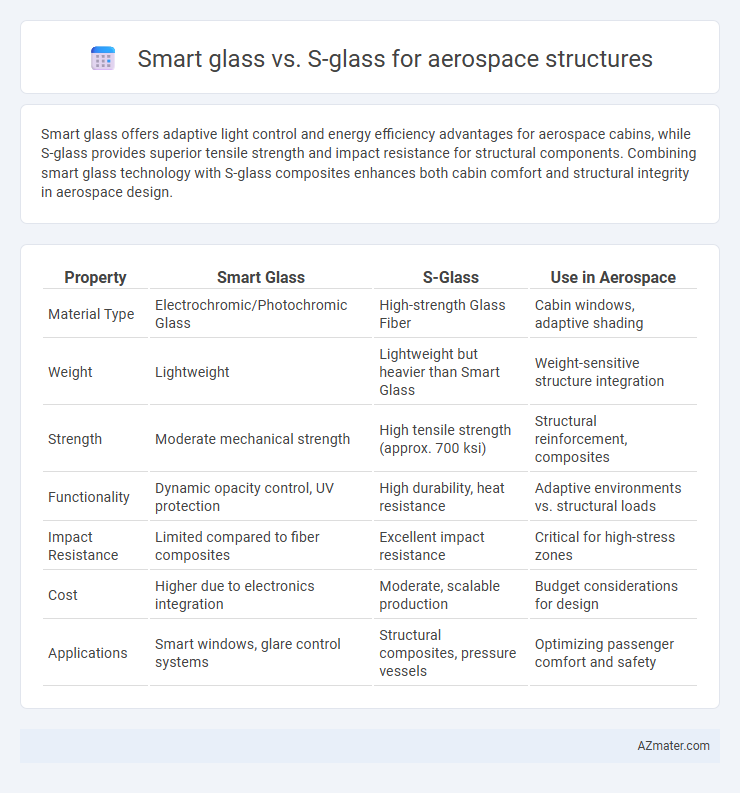Smart glass offers adaptive light control and energy efficiency advantages for aerospace cabins, while S-glass provides superior tensile strength and impact resistance for structural components. Combining smart glass technology with S-glass composites enhances both cabin comfort and structural integrity in aerospace design.
Table of Comparison
| Property | Smart Glass | S-Glass | Use in Aerospace |
|---|---|---|---|
| Material Type | Electrochromic/Photochromic Glass | High-strength Glass Fiber | Cabin windows, adaptive shading |
| Weight | Lightweight | Lightweight but heavier than Smart Glass | Weight-sensitive structure integration |
| Strength | Moderate mechanical strength | High tensile strength (approx. 700 ksi) | Structural reinforcement, composites |
| Functionality | Dynamic opacity control, UV protection | High durability, heat resistance | Adaptive environments vs. structural loads |
| Impact Resistance | Limited compared to fiber composites | Excellent impact resistance | Critical for high-stress zones |
| Cost | Higher due to electronics integration | Moderate, scalable production | Budget considerations for design |
| Applications | Smart windows, glare control systems | Structural composites, pressure vessels | Optimizing passenger comfort and safety |
Introduction to Aerospace Glass Materials
Smart glass and S-glass serve distinct roles in aerospace structures due to their unique properties. Smart glass offers dynamic control of light transmission, enhancing energy efficiency and passenger comfort in aircraft cabins. S-glass, a high-strength aerospace-grade fiberglass, provides exceptional tensile strength and thermal resistance, making it ideal for structural components requiring durability and lightweight performance.
Defining Smart Glass and S-Glass
Smart glass in aerospace structures refers to advanced materials capable of altering their optical properties, such as transparency or reflectivity, in response to electrical, thermal, or light stimuli, enhancing energy efficiency and passenger comfort. S-Glass is a high-strength fiberglass with superior tensile strength and stiffness, predominantly used in aerospace composites to improve structural integrity while reducing weight. Understanding the distinct functionalities of smart glass's adaptive features and S-Glass's mechanical properties is critical for optimizing aerospace design and performance.
Mechanical Properties Comparison
Smart glass and S-glass differ significantly in mechanical properties critical for aerospace structures, with S-glass exhibiting superior tensile strength of approximately 4.8 GPa compared to typical smart glass variants. S-glass offers enhanced impact resistance and a higher modulus of elasticity around 86 GPa, providing greater structural durability and stiffness under load. While smart glass integrates adaptive optical features, S-glass remains preferred for mechanical performance in high-stress aerospace applications.
Weight and Structural Efficiency
Smart glass in aerospace structures offers adaptive transparency with minimal weight addition, enhancing structural efficiency by reducing reliance on traditional shading and lighting systems. S-glass exhibits exceptional tensile strength and stiffness compared to E-glass, providing higher strength-to-weight ratios crucial for aerospace components where every gram impacts performance. The trade-off between the intelligent functionality of smart glass and the superior mechanical properties of S-glass necessitates careful material selection based on specific aerospace weight and structural efficiency requirements.
Thermal Performance and Insulation
Smart glass offers advanced thermal performance by dynamically adjusting its tint to control solar heat gain, significantly reducing cooling loads in aerospace cabins. S-glass, known for its high tensile strength and superior thermal resistance, provides effective insulation against extreme aerospace temperature fluctuations. Combining smart glass technology with S-glass materials enhances overall insulation efficiency, ensuring optimal temperature regulation and energy savings in aerospace structures.
Impact Resistance and Durability
Smart glass offers enhanced impact resistance through its ability to absorb and distribute energy, reducing structural damage in aerospace applications compared to conventional S-glass. S-glass, known for its high tensile strength and fatigue resistance, provides excellent durability under cyclic loading but is more susceptible to brittle failure upon high-impact events. Combining smart glass technology with S-glass composites can optimize both impact resistance and long-term durability in aerospace structural components.
Electrical and Optical Features
Smart glass, often incorporating electrochromic or photovoltaic technologies, offers dynamic control over transparency and light transmission in aerospace structures, enhancing energy efficiency and passenger comfort. S-glass, a high-strength fiberglass, provides superior mechanical properties with stable optical clarity but lacks electrical responsiveness and dynamic light modulation capabilities. The integration of smart glass in aerospace enables electrically tunable optical features, whereas S-glass primarily contributes to structural reinforcement without electrical functionality.
Integration with Aerospace Systems
Smart glass enhances aerospace structures by dynamically controlling light and heat transmission, improving cabin comfort and reducing energy consumption. S-glass offers superior tensile strength and impact resistance, making it ideal for structural reinforcement and composite materials in aerospace frames. Integration of smart glass requires advanced control systems and power management, while S-glass seamlessly fits into existing composite manufacturing processes without added electronic complexity.
Cost and Manufacturing Considerations
Smart glass offers adaptive light control, reducing in-flight energy costs, yet its higher initial expense and complex manufacturing process contrast with S-glass, which features lower material costs and simpler fabrication techniques. S-glass provides superior tensile strength and thermal resistance, favored in aerospace structures requiring robustness and cost-efficiency. Manufacturing smart glass demands advanced technology and precision, increasing production time, while S-glass benefits from established, scalable manufacturing methods reducing overall expenditure.
Future Trends in Aerospace Glass Technology
Smart glass technology in aerospace structures offers dynamic light control and enhanced energy efficiency, outperforming traditional S-glass composites known for high strength and thermal resistance but lacking adaptive capabilities. Future trends indicate a convergence where smart glass integrates with advanced composite materials like S-glass to create multifunctional aerospace skins that improve fuel efficiency, pilot comfort, and structural health monitoring. Research emphasis is on developing lightweight, durable smart glass composites with embedded sensors and real-time data analytics for next-generation aircraft.

Infographic: Smart glass vs S-glass for Aerospace structure
 azmater.com
azmater.com